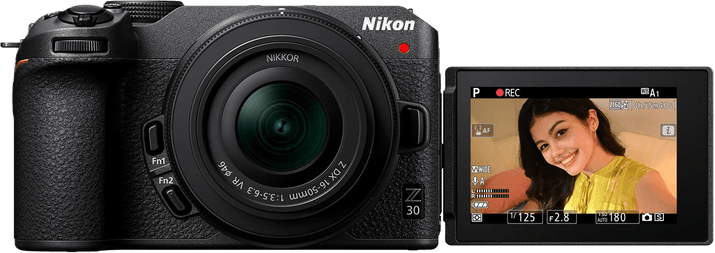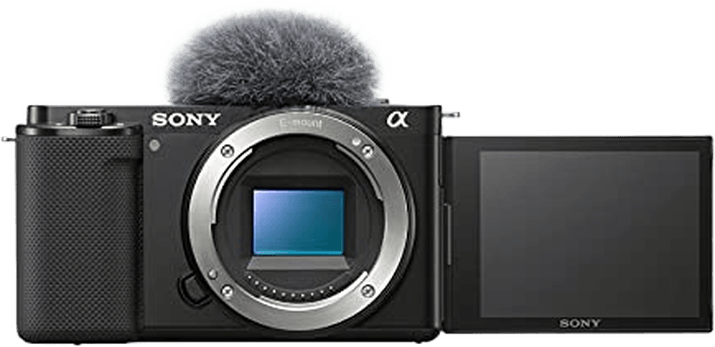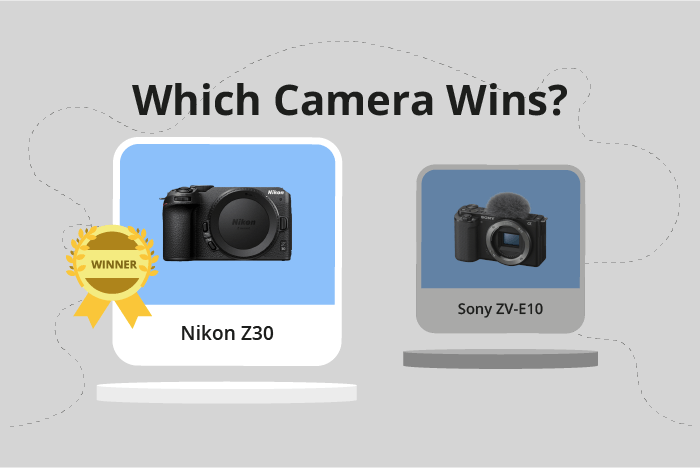Nikon Z30 vs Sony ZV-E10 Comparison
Nikon Z30

Sony ZV-E10

The Nikon Z30 outperforms the Sony ZV-E10 with a score of 72/100 compared to 65/100. Both mirrorless cameras share similarities in their release dates, with the Z30 announced on 06/29/2022 and the ZV-E10 on 07/27/2021. Their launch prices are nearly identical at $710 and $700, respectively.
The Nikon Z30 excels in its larger size (128 x 74 x 60mm) and heavier weight (405g / 0.89lbs), offering a more substantial feel and potentially better stability. On the other hand, the Sony ZV-E10’s smaller size (115 x 64 x 45mm) and lighter weight (343g / 0.76lbs) provide the advantage of portability and ease of handling.
Considering the scores and specifications, the Nikon Z30 is the superior camera, providing a better overall experience. However, the Sony ZV-E10 remains a viable option for those prioritizing compactness and portability.
Nikon Z30 vs Sony ZV-E10 Overview and Optics
The Nikon Z30 emerges as the winner in the optics comparison with a score of 72/100, while the Sony ZV-E10 scores slightly lower at 69/100. Both cameras share some common specifications, such as an 11 fps shooting speed, CMOS sensor type, APS-C sensor size, and lack of image stabilization. However, there are key differences that contribute to the Nikon Z30’s higher score.
The Nikon Z30 boasts a DXOMARK score of 97 for its sensor, compared to Sony ZV-E10’s score of 86. This indicates that the Z30’s sensor provides better image quality and performance. The Z30 also features Nikon’s Expeed 6 processor, which is known for its efficiency and speed, while the ZV-E10 uses Sony’s Bionz X processor.
Though the Sony ZV-E10 has a higher megapixel count of 24 compared to Nikon Z30’s 20 megapixels, the difference in image quality is not significant. The ZV-E10 also has a 4:3 aspect ratio, which may be preferred by some users for certain applications, while the Z30 has a 3:2 aspect ratio.
When it comes to lens compatibility, the Nikon Z30 uses the Nikon Z mount, and the Sony ZV-E10 uses the Sony E mount. This means that each camera is compatible with a different set of lenses, which could be a deciding factor for some users.
The Nikon Z30’s superior sensor performance and efficient processor give it an edge in the optics comparison. However, the Sony ZV-E10’s higher megapixel count and different aspect ratio may still appeal to certain users. Ultimately, the choice between these two cameras will depend on individual preferences and specific needs.
Nikon Z30 vs Sony ZV-E10 Video Performance
The Nikon Z30 and Sony ZV-E10 have been compared for their video capabilities, and both cameras have achieved a video score of 91/100. This equal score indicates that the two cameras have similar performance in terms of video quality and features.
Both cameras offer 4K video resolution, providing high-quality video output for users. They also share the same maximum video frame rate of 120fps, which allows for smooth slow-motion video capture. Additionally, both cameras have built-in time-lapse functionality, enabling users to create stunning time-lapse videos with ease.
The Nikon Z30 has a slight advantage in maximum video dimensions, with 3841 x 2160 pixels, compared to the Sony ZV-E10’s 3840 x 1920 pixels. This minor difference in video dimensions gives the Nikon Z30 a marginal edge in terms of video quality.
On the other hand, the Sony ZV-E10 does not have any notable advantages over the Nikon Z30 in terms of video capabilities, as they share many of the same features and specifications. The equal video score of 91/100 reinforces this point.
Given the similarities in video capabilities, choosing between the Nikon Z30 and Sony ZV-E10 largely depends on individual preferences and other factors such as price, design, and brand loyalty. Both cameras offer excellent video quality and features, making them suitable options for users looking to capture high-quality video content.
Nikon Z30 vs Sony ZV-E10 Features and Benefits
The Nikon Z30 outperforms the Sony ZV-E10 in features, scoring 83/100 compared to the Sony’s 68/100. Both cameras share several specifications, making them suitable for various photography and videography needs.
Common features include a 3-inch screen, touchscreen capabilities, flip screens, and the absence of GPS. Both cameras also come equipped with WIFI and Bluetooth connectivity. These shared specifications make both cameras versatile and user-friendly, catering to a range of users from beginners to professionals.
The Nikon Z30 excels with its higher screen resolution of 1,040,000 dots, compared to the Sony ZV-E10’s 920,000 dots. This difference allows the Nikon Z30 to provide clearer and more detailed image previews, enabling users to better compose shots and review captured images. The higher feature score of the Nikon Z30 reflects its superior capabilities in this area.
While the Sony ZV-E10 falls short in screen resolution, it still offers a competitive set of features. Its touchscreen, flip screen, WIFI, and Bluetooth capabilities make it a viable option for photographers and videographers who value connectivity and ease of use. However, its lower feature score indicates that it may not be the best choice for those prioritizing image preview quality.
Taking these factors into account, the Nikon Z30 stands out as the better camera in terms of features. Its higher screen resolution grants users a more enjoyable photography experience through improved image previews. Meanwhile, the Sony ZV-E10 remains a valid option for those who prioritize convenience and connectivity but may not be ideal for users with higher image quality demands.
Nikon Z30 vs Sony ZV-E10 Storage and Battery
The Nikon Z30 outperforms the Sony ZV-E10 in storage and battery with a score of 35/100, compared to the Sony’s 24/100. Both cameras have one memory card slot and accept SD, SDHC, and SDXC cards. However, the Sony ZV-E10 also supports Memory Stick Pro Duo cards.
The Nikon Z30’s advantage lies in its USB charging capability, which the Sony ZV-E10 lacks. This feature allows for more convenient charging options on the go. The battery type for the Nikon Z30 is the EN-EL25, providing 330 shots per charge.
On the other hand, the Sony ZV-E10 has a longer battery life with 440 shots per charge, using the NP-FW50 battery. This is a notable advantage for extended shooting sessions without access to charging facilities.
To sum up, the Nikon Z30 offers greater charging convenience, while the Sony ZV-E10 provides a longer battery life. The choice between these two cameras depends on the user’s priorities and shooting requirements.
Alternatives to the Nikon Z30 and Sony ZV-E10
Are you still undecided about which camera is right for you? Have a look at these popular comparisons that feature the Nikon Z30 or the Sony ZV-E10:

